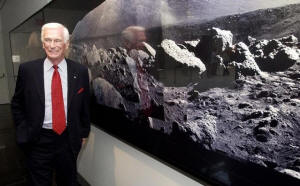|
Gene Cernan, last astronaut to walk on
moon, dies at 82
 Send a link to a friend
Send a link to a friend
 [January 17, 2017]
(Reuters) - Eugene Cernan, the last
astronaut to walk on the moon - an experience that he said made him
"belong to the universe," died on Monday at the age of 82, the U.S.
space agency said. [January 17, 2017]
(Reuters) - Eugene Cernan, the last
astronaut to walk on the moon - an experience that he said made him
"belong to the universe," died on Monday at the age of 82, the U.S.
space agency said.
Cernan, who was also the second man to walk in space, died surrounded by
his family, the National Aeronautics and Space Administration said in a
statement without providing details.
A separate statement from his family and released by NASA said his death
came after "ongoing health issues."
Cernan and fellow Apollo 17 astronaut Harrison Schmitt became members of
the most exclusive club in the universe on Dec. 11, 1972, when they
stepped from their lunar landing module onto the moon's surface. Only 10
other people - all American astronauts - had done so before and none
since.
"Oh, my golly," Cernan told mission control in Houston as he touched the
moon. "Unbelievable."
For three days, the moon was home for Cernan and Schmitt. They rambled
more than 19 miles (30 km) in their lunar roving vehicle and gathered
more than 220 pounds (100 kg) of rocks during their 22 hours of
exploration of craters and hills.
"I knew that I had changed in the past three days and that I no longer
belonged solely to the Earth," Cernan wrote in a memoir titled "The Last
Man on the Moon." "Forever more, I would belong to the universe."

Cernan was 38 years old when he blasted off for the moon on Dec. 7,
1972, as commander of Apollo 17. With Ronald Evans orbiting above in the
command module, Cernan and Harrison Schmitt, a geologist, rode the lunar
lander to the moon's surface four days later.
They explored for about seven hours each day and Cernan wrote that
moonwalking was painful for him because he had injured a tendon in his
leg two months earlier playing softball.
On the day before returning to the command module, Cernan drove the
rover to a point away from the lunar module so that a camera on the
vehicle could film their departure. He then paid tribute to his young
daughter, Tracy.
"I took a moment to kneel and with a single finger, scratched Tracy's
initials, TDC, in the lunar dust, knowing those three letters would
remain there undisturbed for more years than anyone could imagine,"
Cernan wrote in his memoir.
The size 10-1/2 boot prints that Cernan made on his walk back to the
module afterward marked the last steps man has taken on the moon. Cernan
said he spoke spontaneously as he returned to the lunar module.
"As we leave the moon and Taurus-Littrow (a deep lunar valley where they
had landed), we leave as we came, and God willing, as we shall return,
with peace and hope for all mankind," he told mission control.
"As I take these last steps from the surface for some time to come, I'd
just like to record that America's challenge of today has forged man's
destiny of tomorrow. Godspeed to the crew of Apollo 17."

WANTED TO STAY
In a 2007 interview for NASA's oral history program, Cernan recalled his
final moments before climbing back in the lander.
"Those steps up that ladder, they were tough to make," he said. "I
didn't want to go up. I wanted to stay a while."
Apollo 17 was Cernan's last flight as an astronaut after 566 hours and
15 minutes in space.
[to top of second column] |

Former astronaut Gene Cernan, the last man to walk on the moon,
stands next to a wall of photographs he made on the Apollo 17
mission, at the Museum of Natural History in New York, May 7, 2004.
REUTERS/Chip East CME

Cernan was born March 14, 1934, and grew up near Chicago. He was in
the military officers training program at Purdue University, where
he first met Neil Armstrong, who would become the first moonwalker.
Cernan became a Navy test pilot and joined the astronaut corps in
October 1963. His first space flight came three years later due to a
tragedy. Cernan and Thomas Stafford had been designated to be the
backups for Gemini 9 and had to take over the three-day mission when
the original crew members were killed in a plane crash.
Cernan became the third person - following a Russian cosmonaut and
U.S. astronaut Ed White - to make a spacewalk on the Gemini mission
and set what was then a record by being outside the spacecraft for
two hours and nine minutes.
In 1969, Cernan was the pilot of the Apollo 10 lunar module that
came within 9.6 miles (15.6 km) of the moon's surface after
separating from the command module. The descent toward the surface
served as a dress rehearsal for Apollo 11, which two months later
delivered the first men to the moon, Armstrong and Buzz Aldrin.
Cernan retired from NASA and the Navy in 1976. As a civilian he
helped start Air One airline, worked as an energy and aerospace
consultant, served as chairman of an engineering company and was a
space commentator for ABC News.
In 2011, after NASA ended the space shuttle program, Cernan joined
Armstrong in testifying before a congressional committee to urge the
government not to give up on space exploration. Cernan was
particularly critical of the decision by President Barack Obama's
administration not to pursue the Constellation program, which aimed
to send astronauts to the moon and Mars.

"I don't think he fully understands what traditional America is all
about because he didn't literally grow up here," Cernan said of
Obama in a 2012 interview with Fox News.
Cernan met his first wife, Barbara, who had been a flight attendant
for Continental Airlines, on a plane. They divorced in 1981 after 20
years and one child and in 1987 he married Jan Nanna with whom he
had two daughters.
Cernan is survived by his wife, Jan Nanna Cernan, his daughter and
son-in-law, Tracy Cernan Woolie and Marion Woolie, step-daughters
Kelly Nanna Taff and husband, Michael, and Danielle Nanna Ellis and
nine grandchildren.
(Reporting by Daniel Trotta; Writing by Bill Trott; Editing by Paul
Simao, Cynthia Osterman and Alan Crosby)
[© 2017 Thomson Reuters. All rights
reserved.]
Copyright 2017 Reuters. All rights reserved. This material may not be published,
broadcast, rewritten or redistributed. |